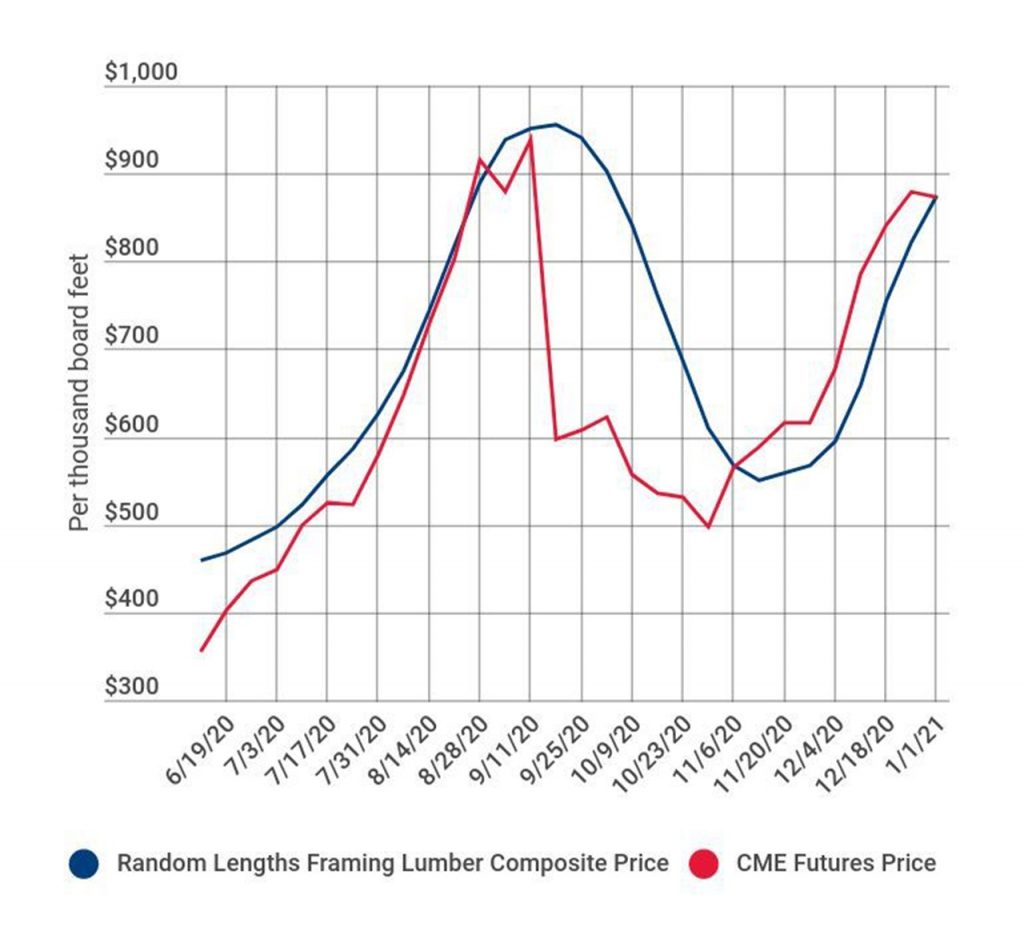Canadian lumber tariffs fall: What happens next?
Back in November 2020, the US Commerce Department slashed Canadian lumber tariffs from 20% to 9%. This act came as a relief, since the 20% tariff likely played a role in skyrocketing lumber prices. Has the tariff slash had a lasting effect, and what happens next?
Did the tariff cuts help?
Yes, for about a month.
Source: NAHB.org
From late October to early December, prices first fell, then slowly began to rise. From mid-December onward, prices spiked yet again, despite the tariff cuts. This proves the wisdom of the NAHB’s Chairman Chuck Fowke, who said that while the tariff reduction was a good start, “more needs to be done.”
Why didn’t the tariff cut have a lasting effect?
The price of lumber doesn’t exist in a vacuum. There are other related factors that can affect what it costs. As you know, in addition to high lumber prices, builders face two gusty headwinds:
- Low supply of housing despite high demand
- Labor shortages among builders
There are several factors that play into the first part of the equation. Volatile lumber prices is one of them, which creates affordability issues down the line. Low housing supply and high lumber prices feed off each other, creating a vicious circle for builders. In other words, it’s hard to increase supply because lumber prices are high, and lumber prices are high in part because of exceedingly high housing demand.
Another is that the costs to build entry-level housing make it hard for builders to justify building those more-affordable homes.
But perhaps the biggest headwind that builders face is the massive shortage in labor. There are many reasons for this shortage, but three seem to stand out among the rest (excluding COVID-19 restrictions).
- Laborers left the industry in the wake of the Great Recession and never came back.
- Younger laborers aren’t filling in the ranks, and when they do, they’re expensive.
- Immigration restrictions reduced the availability of laborers.
That third point is especially interesting. Consider what Bruce Gunter, president of Civitas Group, said regarding immigration restrictions and their effect on the labor shortage.
“This is now an old story—the clamping down on immigration has hurt a lot of homebuilders. . . . A lot of the workers were Hispanic and clamping down on them constrained a source of labor. Replacements, when they were available, came at a higher cost.”
What more can be done?
Addressing the housing supply shortage likely requires addressing the labor shortage. While the NAHB continues to lobby for more sustainable and affordable lumber supplies, here are a couple of things that could tilt in the favor of builders.
A new administration that loosens immigration restrictions. The Biden Administration has stated that it will roll back some of the more restrictive immigration policies currently active. Based on Gunter’s hypothesis, this could increase the size of the available and more affordable labor force.
A COVID-19 vaccine. Early results of the effectiveness of several COVID-19 vaccines have been overwhelmingly positive. As more people receive the vaccine, it’s more likely that the country will begin opening up again. That would likely mean fewer supply-chain interruptions, more citizens finding work, and simply more economic activity.
Is there anything a builder like me can do right now?
Yes! The NAHB encourages builders to start recruiting for the next generation of skilled workers now. By meeting young skilled workers where they are, you can give them the skills and introduction to your company they’ll need to consider working for you.
You can also continue promoting yourself, especially online. Check out six marketing tips for builders that you can start using to expand your footprint.
Finally, you can purchase structural warranty coverage from 2-10 Home Buyers Warranty (2-10 HBW) by becoming a Builder Member. As the industry leader in structural coverage, 2-10 HBW protects your bottom line against qualified structural defects. With the volatile pricing of lumber, the constant labor shortage, and the threat of implied warranties, a structural warranty can keep you moving forward when the unexpected happens.
Learn how you can protect your business and add valuable selling points to your new builds with a 2-10 HBW structural warranty.
Related content
How Will Record-High Lumber Prices Affect New Home Sales?









